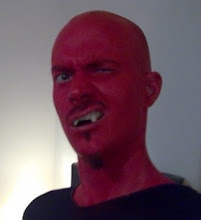Benefiting from the
introduction of modern Japanese horror with Hideo Nakata’s Ring films, Audition
was the first of Takashi Miike’s huge catalogue of films to secure a UK
theatrical release.
Subtle and understated
compared to some of his more infamous films, the low-key domestic scenes of the
first two thirds feel very much like a melodrama. The story concerns a
middle-aged man seeking a May-to-December relationship following the death of
his wife, but after some ethically murky film casting sessions to find a
girlfriend (the titular Audition), the film swiftly descends into the
whacked-out horror and gore that some Miike fans enjoy.
The very slow set-up and
stark contrast of the familiar first two acts with the pre torture-porn torture
of the last is what helps the film stand out, as well as the evident confidence
of Miike’s direction for what was his 30th film (though only the 9th that
wasn’t straight-to-video).
However, it doesn’t really
bear repeat viewing, with foreknowledge draining the film of most of the dread
and tension. The scenes of torture still feel pretty strong, even though the 14
years since Audition’s 1999 release have seen a mini-revival of gore for gore’s
sake in some sectors of the horror genre.
Worth a watch but not quite
the classic of J-horror.
Insidious
James Wan’s Saw dealt more
with the psychological horror of being trapped, and having to commit to
performing nasty acts of violence on yourself and others to escape, as it did
with the gory results - a fact easily forgotten as you look at how the series
has progressed.
The same writer/director team
of Wan and write Leigh Whannel sees Insidious backed up with some excellent
pacing, building tension alongside the odd jump, and aided by some great turns
from Rose Byrne and Patrick Wilson as the parents of Dalton, a boy who can
astral project and whose body is the target of ghosts and demons, as well as
some brilliant lighting and framing.
Whilst the story itself is
similar to a number of haunted house entries, Insidious takes the route of
psychological chills with a comparative lack of violence or bloodshed over an
extended build-up.
Comic relief is offered later
on with the introduction of a ghost hunting double act, though Wan still
manages to keep the tension heightened even while offering brief openings of
relief through humour.
In a second viewing at the
cinema I found Insidious as good as I remembered it the first time round -
despite knowing when and how the scares were coming it still succeeded in
raising the hairs on the back of my neck - creepy is an apt term, and in
keeping with the name ‘Insidious’ itself. One of the better examples of new
millennium horror so far.
Insidious: Chapter 2
Chapter 2 starts off on the
back foot immediately due to a decision to overdub a younger actress playing ghosthunter/psychic
Elise with Lin Shaye’s current voice. Whilst the original voice helps link the
character for fans without too much exposition beyond a flash of “1986” as the
character climbs the stairs to a creepy house, the timbre is wrong and jars you
out of the film, taking you out of the crucial suspension of disbelief you
need.
Overall Chapter 2 is a disappointment,
though this is not to say it’s a bad film - intentionally funnier than the
original and clever in the way it links elements of the first film with its
narrative - at one point rewatching the first Insidious I found myself
wondering why the apparitions give the unfortunate humans such a run around,
only to have spookier elements of self-opening doors and such explained in the
second.
A number of genre tropes are
ticked off in a seemingly list-building manner, with creepy kids toys, an
abandoned hospital, a main character murderously possessed, body failure
represented by teeth falling out and a ghost hunter’s spooky souvenir room all
making an appearance, and a number of these have their tension drained as the
film splits its narrative. One group of characters find themselves in direct
danger from the now possessed Josh (Patrick Wilson) whilst another spend much
of the film uncovering the back story to both chapters. The twist of the first
film’s astral projection is now known, and in its place the idea that the old
ghostly bride taking Josh’s body is actually the spirit of a male murderer with
gender and mother issues finds itself less shocking five decades after Psycho.
Alongside the humour the cast
remain strong, with Barbara Hershey as Josh’s mother Lorraine and Lin Shaye as
Elise given more to do, as well as Lin’s assistants Specs and Tucker (writer
Whannel and Angus Sampson respectively). As well as these and Wilson and Byrne
also as good as in the first, Jocelin Donahue is a good pick for the younger
Lorraine, both for looking like Hershey and recent horror heritage as the lead
in the wonderful 70's horror homage, House of the Devil..
One for completists, not as
satisfying as the original and definitely not a stand alone watch.





0 comments:
Post a Comment